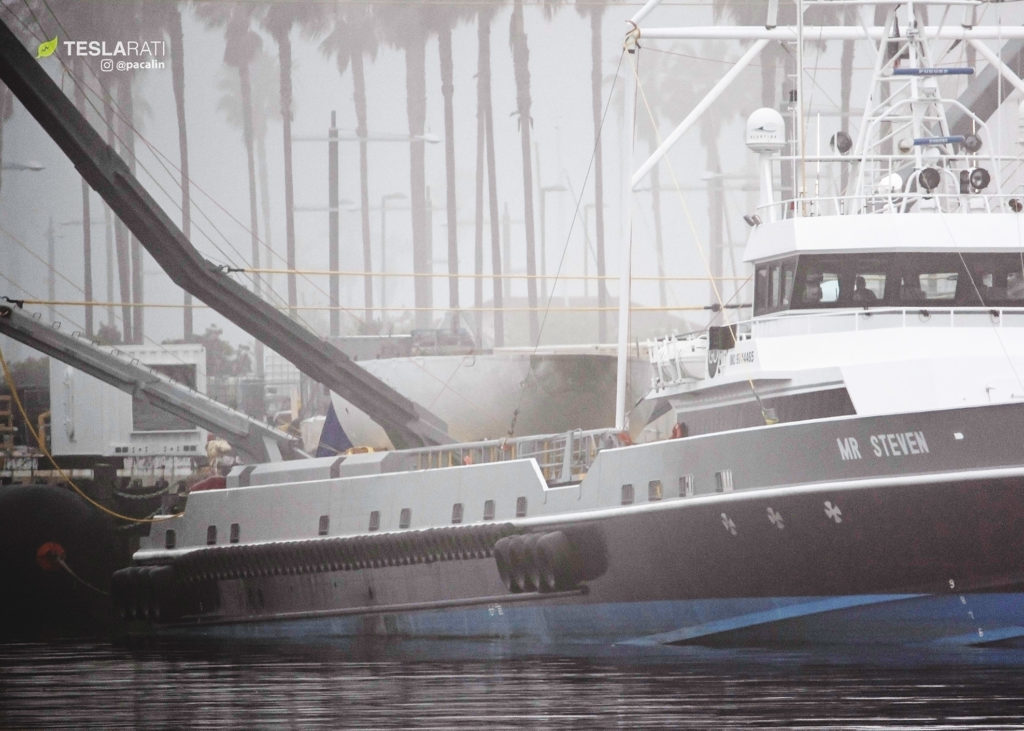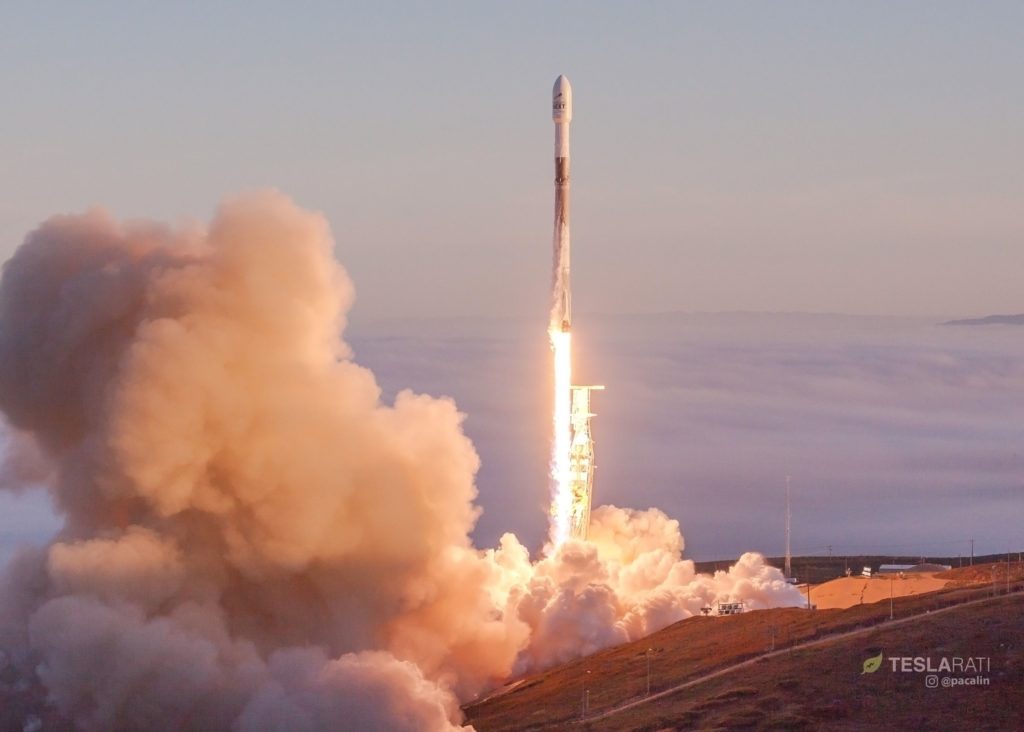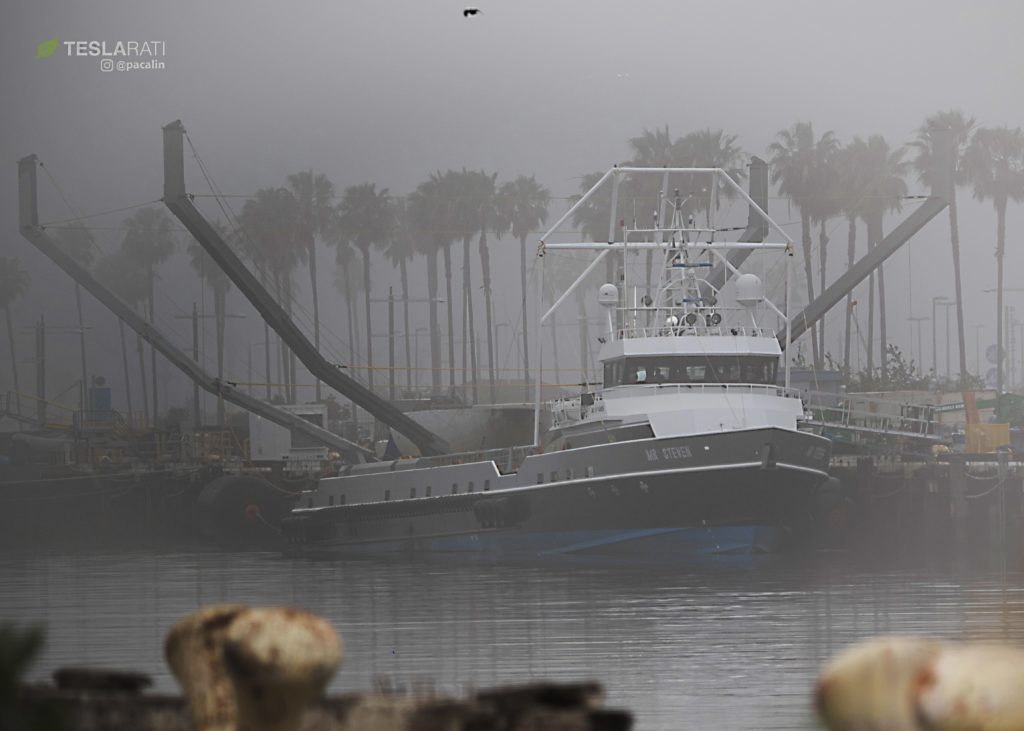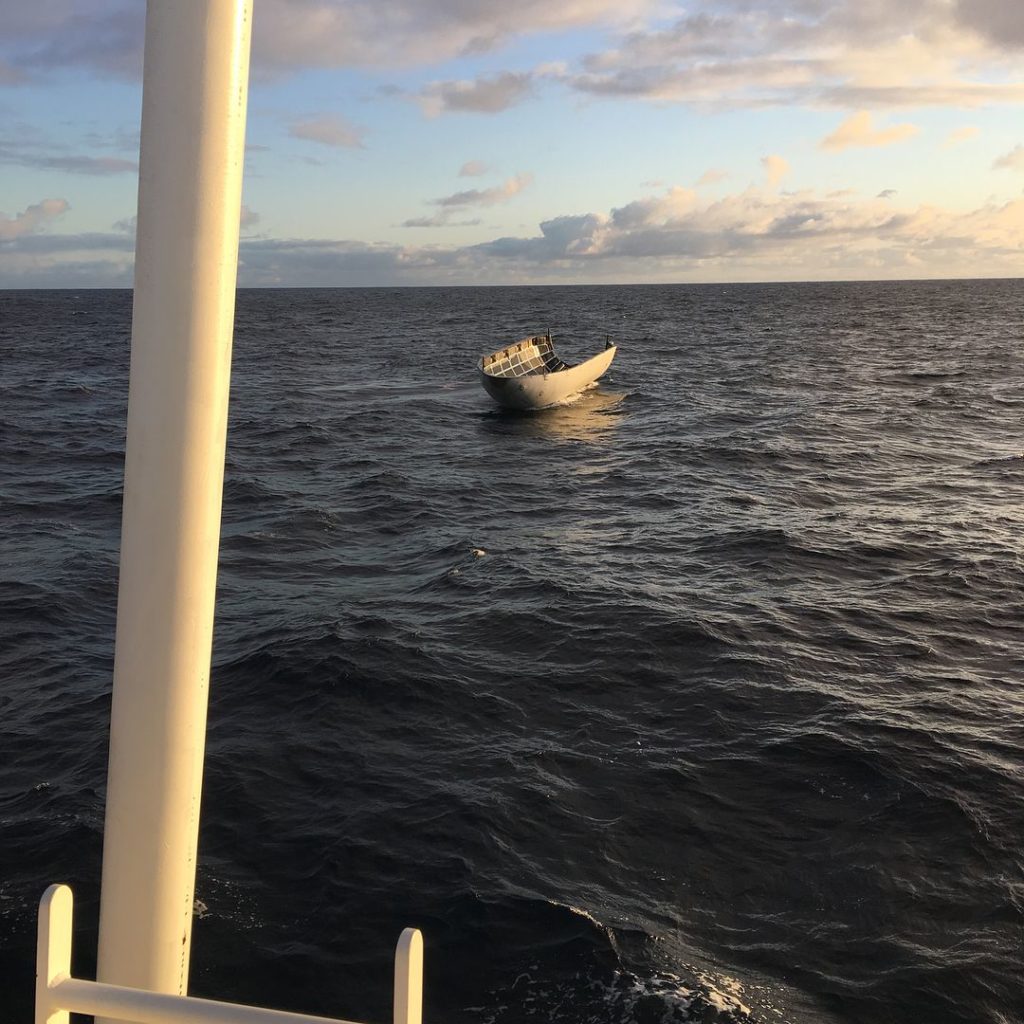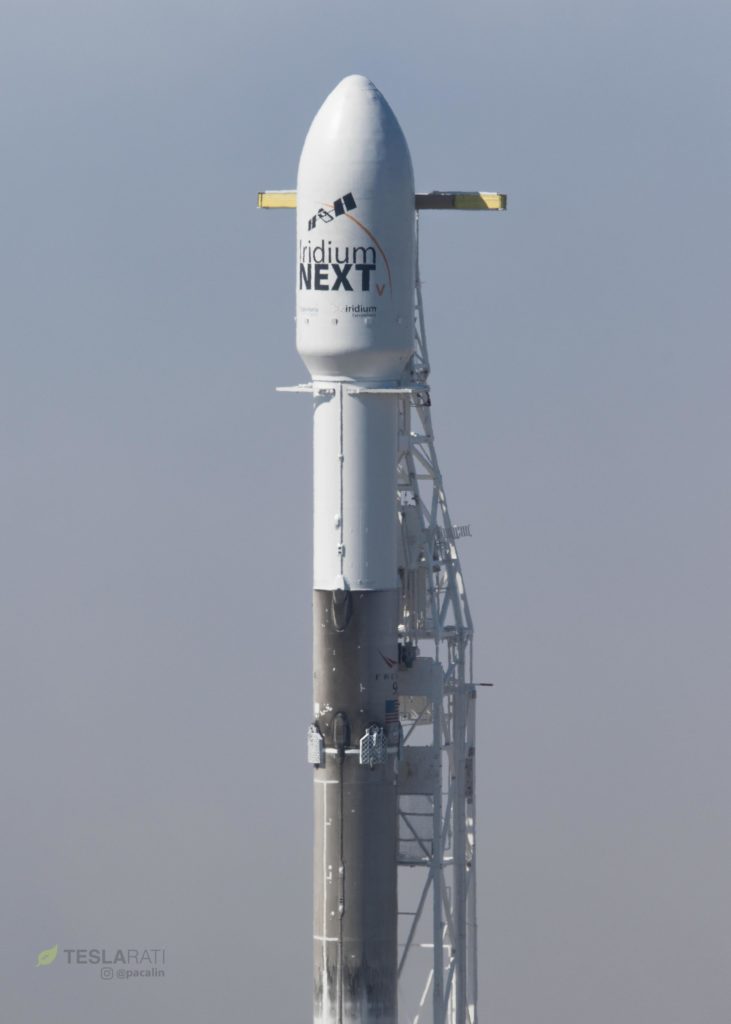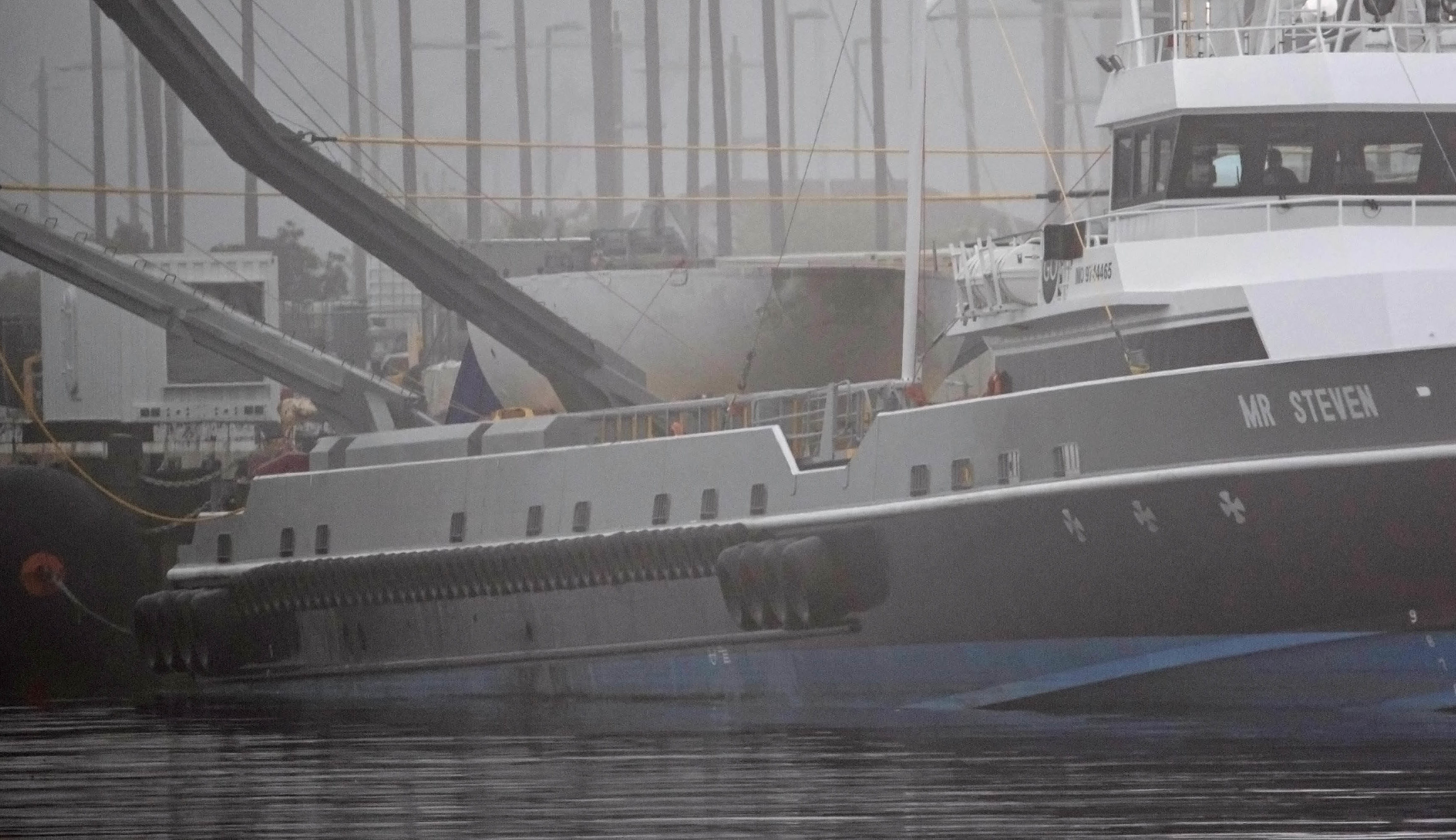

News
SpaceX returns intact fairing half on clawboat in post-launch surprise
Despite a statement from SpaceX CEO Elon Musk that the Iridium-5 mission’s fairing recovery attempt had failed due to a twisted parafoil, Teslarati captured photos of clawboat Mr Steven arriving in the Port of San Pedro early Saturday morning with an apparently intact fairing half.
Not to be confused with the first successfully recovered fairing that returned to land in late February, this half is undoubtedly fresh from Iridium-5’s Friday morning launch. The $2.5 million, carbon composite aluminum fairing half recovered during SpaceX’s PAZ mission on February 22 is currently being stored and scrapped at SpaceX’s brand new port real estate – Berth 240, or the same location that was selected as the probable location for SpaceX’s first BFR manufacturing facility.
- The Iridium-5 half, however, is not believed to have suffered any significant structural damage during recovery ops. (Pauline Acalin)
- Falcon 9 1041 rises above a sea of fog for one last mission to orbit. Half of its fairing made a surprise appearance in port on Saturday. (Pauline Acalin)
- An unmistakable Falcon 9 fairing half seen aboard the vessel Mr Steven on Saturday morning. (Pauline Acalin)
- Teslarati photographer Pauline Acalin made her way to a foggy Port of San Pedro early Saturday morning to welcome Mr Steven home. (Pauline Acalin)
Compared to Musk’s previous comments during the first intact fairing recovery in late February, it would seem that Iridium-5’s fairing was all but doomed when it “impacted [the] water at high speed,” and the majority of fans appeared to have concluded as much. Following PAZ, Musk tweeted that the Mr Steven had “missed by a few hundred meters, but fairing landed intact in water” – as an incredibly optimized and lightweight structure, a fairing half would likely have to land very gently to avoid breaking into pieces. That Mr Steven’s crew was able to bring the Iridium-5 half aboard all but guarantees that it was floating intact on the ocean surface after touching down.
GPS guided parafoil twisted, so fairing impacted water at high speed. Air wake from fairing messing w parafoil steering. Doing helo drop tests in next few weeks to solve.
— Elon Musk (@elonmusk) March 30, 2018
This does not necessarily contradict Musk’s diagnosis of a twisted parafoil, assuming he was referring to the lines that connect the fairing to the foil – paragliders frequently suffer tangles and twists in their lines, an event that typically warps the parafoil’s structure, thus lowering the amount of lift it can produce as a wing. This is an inevitable risk of what is basically a self-inflating wing, and failures of this sort are known to kill or injure paragliders at low altitudes and can also lead to uncontrolled spinning (although that is very unlikely to occur with a 1000kg payload).
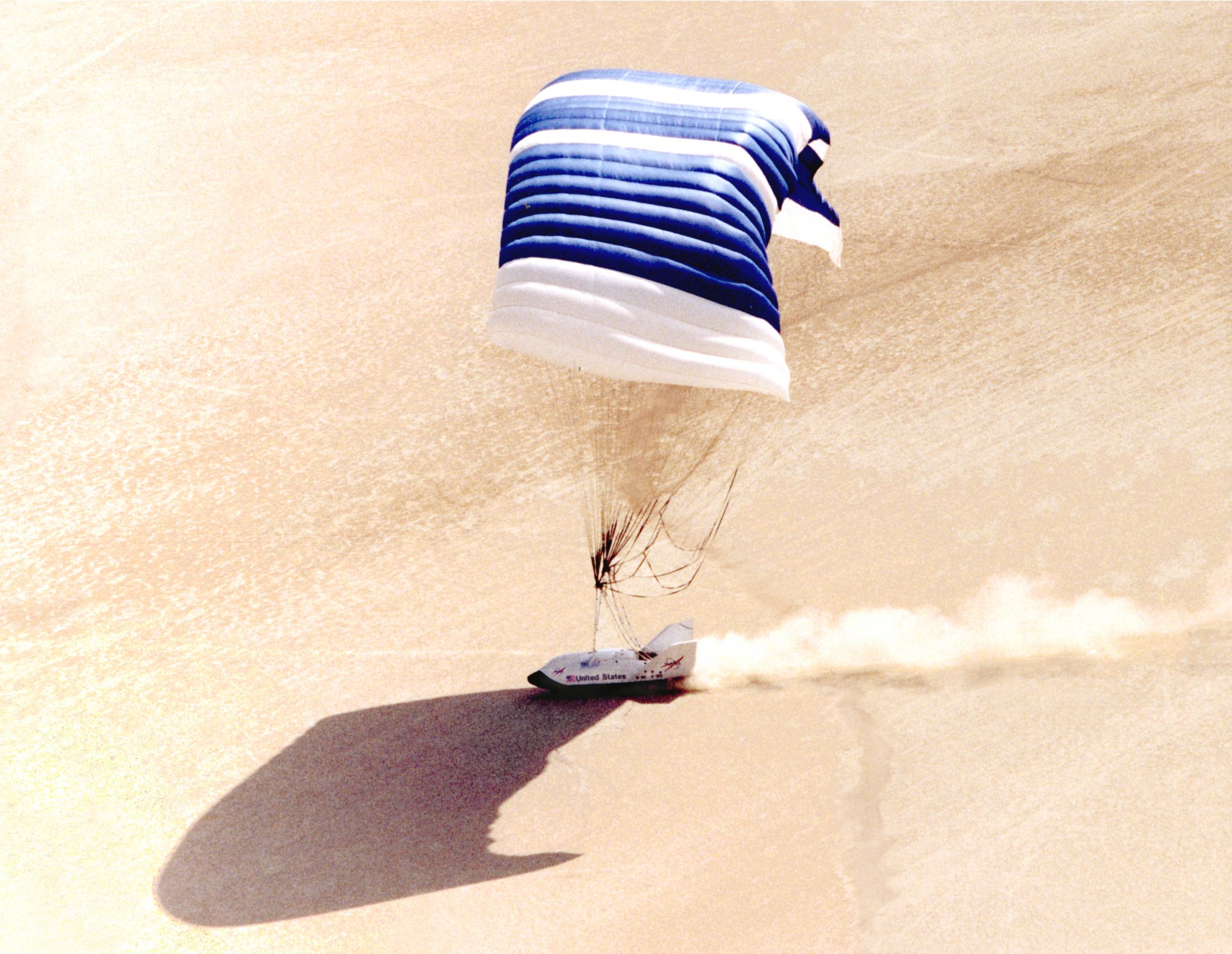
A NASA experiment in the late 90s examined the use of a parafoil to enable gentle, guided landings of an orbital escape pod – the experiment was quite successful. (NASA)
Ultimately, GPS-guided parafoils have been done fairly successfully and many times over during the past two or so decades. For the most part,the problems preventing SpaceX from recovering fairings in Mr Steven’s net have been almost entirely solved: the fact that two fairing halves have been recovered intact after their last two Western launches confirm as much. SpaceX engineers have somehow found a way to enable a highly flexible, lightweight, and aerodynamically awkward lifting body to survive a journey from heights of 110+ km and speeds of more than 2250 meters per second.
SpaceX’s fairings may look unassuming dressed in their subtle soot and simple curved lines, but – as SpaceX has intoned in the past – if landing massive Falcon 9 boosters after launch is akin to “launching a pencil over the Empire State building and having it land on a shoebox on the other side…during a wind storm,” recovering the relatively minuscule and light fairings can be fairly compared to launching a paper bowl over two stacked Empire State Buildings in a tornado and catching it with one hand behind your back on the opposite side – all without ripping, folding, or denting it.
- It may look unassuming, but that fairing half could swallow an entire school bus and by all means should not be in one piece. (Fairing from PAZ, photo by Elon Musk)
- Falcon 9 B1041.2 seen before launching Iridium-5. (Pauline Acalin)
SpaceX is 99% of the way to successful and routine fairing recovery and reuse and the final 1% is all about testing and subtle refinement. Future fairing recovery attempts may even be streamed in real time on SpaceX’s webcasts, according to Musk.
Follow us for live updates, behind-the-scenes sneak peeks, and a sea of beautiful photos from our East and West coast photographers.
Teslarati – Instagram – Twitter
Tom Cross – Twitter
Pauline Acalin – Twitter
Eric Ralph – Twitter
Elon Musk
Why Tesla’s Q3 could be one of its biggest quarters in history
Tesla could stand to benefit from the removal of the $7,500 EV tax credit at the end of Q3.

Tesla has gotten off to a slow start in 2025, as the first half of the year has not been one to remember from a delivery perspective.
However, Q3 could end up being one of the best the company has had in history, with the United States potentially being a major contributor to what might reverse a slow start to the year.
Earlier today, the United States’ House of Representatives officially passed President Trump’s “Big Beautiful Bill,” after it made its way through the Senate earlier this week. The bill will head to President Trump, as he looks to sign it before his July 4 deadline.
The Bill will effectively bring closure to the $7,500 EV tax credit, which will end on September 30, 2025. This means, over the next three months in the United States, those who are looking to buy an EV will have their last chance to take advantage of the credit. EVs will then be, for most people, $7,500 more expensive, in essence.
The tax credit is available to any single filer who makes under $150,000 per year, $225,000 a year to a head of household, and $300,000 to couples filing jointly.
Ending the tax credit was expected with the Trump administration, as his policies have leaned significantly toward reliance on fossil fuels, ending what he calls an “EV mandate.” He has used this phrase several times in disagreements with Tesla CEO Elon Musk.
Nevertheless, those who have been on the fence about buying a Tesla, or any EV, for that matter, will have some decisions to make in the next three months. While all companies will stand to benefit from this time crunch, Tesla could be the true winner because of its sheer volume.
If things are done correctly, meaning if Tesla can also offer incentives like 0% APR, special pricing on leasing or financing, or other advantages (like free Red, White, and Blue for a short period of time in celebration of Independence Day), it could see some real volume in sales this quarter.
You can now buy a Tesla in Red, White, and Blue for free until July 14 https://t.co/iAwhaRFOH0
— TESLARATI (@Teslarati) July 3, 2025
Tesla is just a shade under 721,000 deliveries for the year, so it’s on pace for roughly 1.4 million for 2025. This would be a decrease from the 1.8 million cars it delivered in each of the last two years. Traditionally, the second half of the year has produced Tesla’s strongest quarters. Its top three quarters in terms of deliveries are Q4 2024 with 495,570 vehicles, Q4 2023 with 484,507 vehicles, and Q3 2024 with 462,890 vehicles.
Elon Musk
Tesla Full Self-Driving testing continues European expansion: here’s where
Tesla has launched Full Self-Driving testing in a fifth European country ahead of its launch.

Tesla Full Self-Driving is being tested in several countries across Europe as the company prepares to launch its driver assistance suite on the continent.
The company is still working through the regulatory hurdles with the European Union. They are plentiful and difficult to navigate, but Tesla is still making progress as its testing of FSD continues to expand.
Today, it officially began testing in a new country, as more regions open their doors to Tesla. Many owners and potential customers in Europe are awaiting its launch.
On Thursday, Tesla officially confirmed that Full Self-Driving testing is underway in Spain, as the company shared an extensive video of a trip through the streets of Madrid:
Como pez en el agua …
FSD Supervised testing in Madrid, Spain
Pending regulatory approval pic.twitter.com/txTgoWseuA
— Tesla Europe & Middle East (@teslaeurope) July 3, 2025
The launch of Full Self-Driving testing in Spain marks the fifth country in which Tesla has started assessing the suite’s performance in the European market.
Across the past several months, Tesla has been expanding the scope of countries where Full Self-Driving is being tested. It has already made it to Italy, France, the Netherlands, and Germany previously.
Tesla has already filed applications to have Full Self-Driving (Supervised) launched across the European Union, but CEO Elon Musk has indicated that this particular step has been the delay in the official launch of the suite thus far.
In mid-June, Musk revealed the frustrations Tesla has felt during its efforts to launch its Full Self-Driving (Supervised) suite in Europe, stating that the holdup can be attributed to authorities in various countries, as well as the EU as a whole:
Tesla Full Self-Driving’s European launch frustrations revealed by Elon Musk
“Waiting for Dutch authorities and then the EU to approve. Very frustrating and hurts the safety of people in Europe, as driving with advanced Autopilot on results in four times fewer injuries! Please ask your governing authorities to accelerate making Tesla safer in Europe.”
Waiting for Dutch authorities and then the EU to approve.
Very frustrating and hurts the safety of people in Europe, as driving with advanced Autopilot on results in four times fewer injuries!
Please ask your governing authorities to accelerate making Tesla safer in Europe. https://t.co/QIYCXhhaQp
— Elon Musk (@elonmusk) June 11, 2025
Tesla said last year that it planned to launch Full Self-Driving in Europe in 2025.
Elon Musk
xAI’s Memphis data center receives air permit despite community criticism
xAI welcomed the development in a post on its official xAI Memphis account on X.

Elon Musk’s artificial intelligence startup xAI has secured an air permit from Memphis health officials for its data center project, despite critics’ opposition and pending legal action. The Shelby County Health Department approved the permit this week, allowing xAI to operate 15 mobile gas turbines at its facility.
Air permit granted
The air permit comes after months of protests from Memphis residents and environmental justice advocates, who alleged that xAI violated the Clean Air Act by operating gas turbines without prior approval, as per a report from WIRED.
The Southern Environmental Law Center (SELC) and the NAACP has claimed that xAI installed dozens of gas turbines at its new data campus without acquiring the mandatory Prevention of Significant Deterioration (PSD) permit required for large-scale emission sources.
Local officials previously stated the turbines were considered “temporary” and thus not subject to stricter permitting. xAI applied for an air permit in January 2025, and in June, Memphis Mayor Paul Young acknowledged that the company was operating 21 turbines. SELC, however, has claimed that aerial footage shows the number may be as high as 35.
Critics are not giving up
Civil rights groups have stated that they intend to move forward with legal action. “xAI’s decision to install and operate dozens of polluting gas turbines without any permits or public oversight is a clear violation of the Clean Air Act,” said Patrick Anderson, senior attorney at SELC.
“Over the last year, these turbines have pumped out pollution that threatens the health of Memphis families. This notice paves the way for a lawsuit that can hold xAI accountable for its unlawful refusal to get permits for its gas turbines,” he added.
Sharon Wilson, a certified optical gas imaging thermographer, also described the emissions cloud in Memphis as notable. “I expected to see the typical power plant type of pollution that I see. What I saw was way worse than what I expected,” she said.
-

 Elon Musk3 days ago
Elon Musk3 days agoTesla investors will be shocked by Jim Cramer’s latest assessment
-

 News1 week ago
News1 week agoTesla Robotaxi’s biggest challenge seems to be this one thing
-

 News2 weeks ago
News2 weeks agoTexas lawmakers urge Tesla to delay Austin robotaxi launch to September
-

 Elon Musk2 weeks ago
Elon Musk2 weeks agoFirst Look at Tesla’s Robotaxi App: features, design, and more
-

 Elon Musk2 weeks ago
Elon Musk2 weeks agoxAI’s Grok 3 partners with Oracle Cloud for corporate AI innovation
-

 News2 weeks ago
News2 weeks agoSpaceX and Elon Musk share insights on Starship Ship 36’s RUD
-

 News2 weeks ago
News2 weeks agoWatch Tesla’s first driverless public Robotaxi rides in Texas
-

 News2 weeks ago
News2 weeks agoTesla has started rolling out initial round of Robotaxi invites

